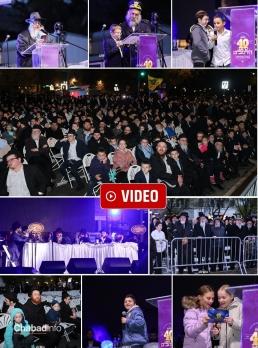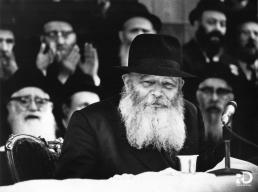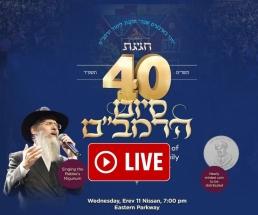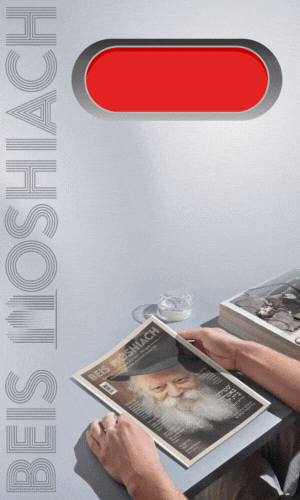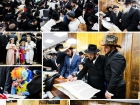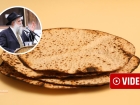Chuppa in New York, Wedding in Pittsburgh: Mekushar, Shliach, Rav. (Part II)
The life and times of veteran Milan rabbi and Shliach R’ Gershon Mendel Garelick a”h, as he related them himself in a series of interviews conducted with Beis Moshiach Magazine • Part II – Youth in 770 and Marriage • Full Article
By Avrohom Rainitz, Beis Moshiach
Click here for part one
The life and times of veteran Milan rabbi and Shliach R’ Gershon Mendel Garelick a”h, as he related them himself in a series of interviews conducted with Beis Moshiach. Part II – Youth in 770 and Marriage
8 – STRAWBERRIES AND BRACHOS
After leaving yechidus, R’ Garelik asked himself, why did the Rebbe tell me to learn Birchos HaNehenin? The other things he told me to learn, Kerias Shema in Likutei Torah, Imrei Bina and in Derech Mitzvosecha I understand, because this pertains to the avodas Hashem of a tamim in Tomchei Tmimim, but why Birchos HaNehenin?
At the time, he thought that maybe it had to do with an incident that occurred in his childhood as follows:
“It was during World War II when we, like many Jews, were wandering from place to place. On one of our journeys, as we traveled toward Almaty, we stopped in the Ural Mountains. The trip was long and exhausting on broken freight trains and we had hardly any food.
“At one of the stations, when the train stopped at the foot of the mountains, I went out with my cousin to breathe some fresh air. We saw many strawberries on the ground near the trees. To us, this was a fabulous treasure and we began filling our pockets with the delicacy.
“When we returned to the train and my father saw what we had brought and I already wanted to eat, he stopped me and began a halachic discussion with his brother-in-law, my uncle, about what bracha should be made on them, ha’eitz or ha’adama.
“They talked and talked and I grew very angry that they were stopping me from eating the strawberries. Don’t forget, this was during the war when food was precious. People suffered from starvation but they continued discussing it. I was so upset that I took all the strawberries out of my pockets and didn’t want to look at them anymore.
“I never forgot this. There was nothing to eat and yet my father was making me problems over some strawberries. Now, when the Rebbe told me to study the laws of brachos, it rang a bell and I connected this with that event and thought this might be why the Rebbe told me to study this subject.
“On second thought, I dismissed this idea and wondered, why brachos? It was clear that this was a special instruction for me, for mashpiim in yeshiva had told us that yechidus is a bonding of yechida and yechida, and the subjects spoken about pertain particularly to that person, especially in the first yechidus which pertains to all of life! Despite everything, I did not understand the instruction and I put the question away in my pocket and fulfilled it with kabbolas ol.
“Obviously, if the Rebbe says to learn, you learn well, and over the years I studied Birchos HaNehenin so that even when they were learning Gemara (or other subjects in yeshiva), I kept a sefer of the laws of brachos under the sefer and now and then I would look inside. For a while, my fellow tmimim who saw me always busy with this even nicknamed me ‘Birchos HaNehenin.’
“It was only over twenty years later that I began to understand why the Rebbe asked me to learn this.”
9 – AN URGENT SPIRITUAL PROBLEM
R’ Garelik yearned to have yechidus again but found out that bachurim only went in once a year, for their birthday. Despite this, he continued looking for ways to get in. He felt he could not wait another year until the next yechidus.
“I heard that in unusual situations, the secretary, Rabbi Chodakov, would allow a bachur in if he had an urgent spiritual problem. I figured I would look for an urgent spiritual problem … When I spoke to R’ Chodakov he warned me, ‘It must be something serious; otherwise, you will never have yechidus with the Rebbe again!’
“I finally found an urgent spiritual problem. I remembered that when I was young, while my father was in jail, I stayed with a relative whose kashrus was not ideal and I wanted to ask for a tikkun for this.
“I wrote the details on a note and asked for a tikkun for the weeks that I did not eat the ultimate in kosher food. I had yechidus and gave the note to the Rebbe. The Rebbe looked at it and answered (with a special tune):
“‘The tikkun for this will be that from today on, you will eat whatever you are served.’
“The yechidus was over in the blink of an eye. I went in, the Rebbe glanced at the note, responded, and I left.”
10 – REBBETZIN CHANA’S CONNECTION TO THE INSTRUCTION IN YECHIDUS
Why did the Rebbe tell me that?
At the time, I thought it was because Rebbetzin Chana told him that I don’t eat enough. As mentioned, I had a nice relationship with Rebbetzin Chana and since I was a skinny bachur, she would urge me to eat well.
11 – DO YOU EAT A LOT?
I followed the Rebbe’s instruction but being in yeshiva where you serve yourself, I was able to fill my plate as I wished. After I married, I wasn’t the only one in charge of filling my plate (and often it is not pleasant to refuse) so I ate and ate until I became fat.
When this became unacceptable, my wife asked me to write about this to the Rebbe. Of course, it hadn’t occurred to me to write to the Rebbe about this and yet, in one yechidus, before I got up to leave, the Rebbe looked at me and said, “I see that you’ve filled out. When you eat, do you eat a lot? Go to Dr. Seligson.”
I went to Dr. Avrohom Seligson and he gave me instructions about eating and the situation improved.
12 – R’ MENDEL ASKED WHY THE REBBE SMILED
After this yechidus, the person after me in line at the next yechidus was R’ Mendel Futerfas. I sat down not far from him to write what happened in yechidus before I forgot.
As I wrote, R’ Mendel came out of yechidus all agitated and asked me, “What did the Rebbe say to you? You must tell me!”
After telling him, he said that when I came out, he went into the Rebbe’s office and saw the Rebbe smiling broadly. This is why R’ Mendel demanded to know what happened that the Rebbe was smiling like that.



The Rebbe is mesader kiddushin at the wedding of Rabbi Garelik (left)
13 – MISSED BY A MINUTE
In 5718, when I was a bachur, a rumor went around that the Rebbe would show up at the Chassidus seder on Shabbos morning to see what goes on. At that time, there was a certain laxity in the Shabbos morning seder. As usual with these things, some believed the rumor and others didn’t.
I got to seder earlier than usual and I was walking in the hall of 770 upstairs. Suddenly, at about 8:00, I heard noises of doors opening and closing. Before I could even figure out what was going on I saw that one of the bachurim was leaning on the Rebbe’s office door and trying to listen.
I asked him what happened and he said that the Rebbe just came to the zal and told all the bachurim who arrived on time to go to his room and close the door (so others would not go in) and the Rebbe was about to say a maamar.
It was 8:01 and I missed it by one minute and remained outside.
14 – THE GREAT REGRET
The Rebbe began to say the maamar “Zachor es asher asa lecha Amalek.” There are two commands, a command of “remember” and a command of “erase.” The kelipa of Amalek is different than other kelipos in that it is not possible to refine it; it needs to be broken. That is its tikkun.
For some people, this message doesn’t speak much to them or at least not any more than other maamarim. The fact that this maamar was said in the Rebbe’s room before davening also does not mean much to them. But for me, who experienced it, I live with this event all the time especially when we get up to Parshas Zachor.
Most painful for me is the fact that I did not go in, not because I didn’t feel well or I came late for seder but because I missed it by a minute. You can call this “batlanus” and here, the Rebbe starts the maamar talking about the breaking that needs to be done with Amalek! There are things that can be refined but with Amalek there is nothing else to be done but break the yeshus!
The personal “breaking” I experienced was total. Right here, beyond the wall was a Mattan Torah event, a rare occurrence, with the Rebbe saying a maamar in his room before davening (in general, it wasn’t possible to enter the yechidus room on just any day) and I stood there outside.
But, here too, I saw the Rebbe’s compassion that a father has for his children. The Rebbe began the maamar by loudly saying, “Remember what Amalek did to you …” so that although we remained outside (and slowly, more bachurim gathered who had arrived late), we heard the entire maamar word for word. However, we were outside …
15 – MESIRUS NEFESH OF A TAMIM
One Tishrei was very cold, more than usual for this time of the year and dozens of bachurim were sick. The dormitory was at 676 Eastern Parkway and many spent the month in bed. The situation was so bad that the Rebbe said that those who were sick should not come for the “birkas ha’tmimim.” Even the elder Chassidim came at that time to visit us in the dormitory.
Shortly before Kol Nidrei I thought, I don’t whether it’s true or not that the Rebbe said not to go to “birkas ha’tmimim,” but just as I don’t have the strength to get up, so too, I cannot lie in bed as the Rebbe blesses his children, the tmimim. I got up and went.
As soon as I left the warm dormitory for the cold outside, I stumbled and fell. Nevertheless, I continued to walk to 770 for birkas ha’tmimim. Over the years, I had always stood as close as possible to the Rebbe but that year I barely managed to squeeze my way in. I heard the Rebbe’s voice but could not see him. When the bracha ended, I returned to the dormitory and continued resting in bed until I recovered.
16 – THE REBBE’S RUACH HA’KODESH IN THE SUCCA
The day after Yom Kippur, R’ Pinchas (Pinye) Altheus came to visit us. Since I knew him well from when I had been in yeshiva in Lud (in my attempts to obtain the necessary papers to be able to go to America), I said to him, “You will, no doubt, be invited to the Yom Tov meals in the succa with the Rebbe, Please mention the names to the Rebbe of those who are sick.”
R’ Pinye said he’d be glad to and suggested that I write the names of all the bachurim who needed a refuah.
The first night of Succos, I was still lying in bed. I thought, can the Rebbe be sitting in the succa and I have the opportunity of being there and I’m here in bed? Once again, I mustered my strength and went to 770.
This is not the place to go into detail but I had my ways of always getting in to the seudos that took place in the house of the Rebbe Rayatz on the second floor of 770. This was something that I specialized in. I arrived, pushed inside and hid, waiting to hear the words that would be spoken at the king’s table.
Suddenly, I heard R’ Pinye bring up the topic of the sick bachurim and he began reading the list. My name was first on the list and as soon as R’ Pinye mentioned my name, I heard the Rebbe say, “Him? He is here!”
Of course, I was completely shaken up and later on, R’ Pinye also “gave it to me.”
The most surprising thing about this story is that anyone familiar with the structure of the succa on the porch of the Rebbe Rayatz’s house, realizes that the Rebbe sat in the corner from where it was simply not possible for him to see the direction from where I arrived.
17 – THE REBBE’S SEDER
When the Rebbe conducted the seder in the home of the Rebbe Rayatz, only a limited number of people sat at the table starting from the beginning of the seder (Kadeish). Other people were allowed in only toward the end of Maggid (after the first two cups). Naturally, it was extremely crowded then with bachurim and married men who came to see the Rebbe’s seder (after they rushed to make a seder at home or in yeshiva).
The bachurim were not allowed in for the first part, aside from waiters who served the food. Being a waiter and serving the Rebbe was no simple thing and a raffle was held for the privilege.
Even the waiters were there only from the beginning of the seder. Before that, nobody was allowed to be in the room. When the Rebbe set up his ke’ara, nobody was watching.
Thanks to my connections, I was at the seder not only from the beginning but even before that, when the ke’ara was set up! The Rebbe began arranging his ke’ara about ten minutes before the seder began and I watched from a spot in the kitchen.
The feeling I had as the ke’ara was being arranged is indescribable. This was an event saturated with outstanding holiness and gravity.
18 – THE REBBE HID THE HORSERADISH
As is already well known, the Rebbe would also eat a piece of horseradish that was not grated. While preparing the ke’ara, I noticed that the Rebbe took the vegetable itself, a large horseradish and cut it with a knife in a sharp, swift move, a sort of broad sweeping motion. This was a large piece of the root.
Then the Rebbe tried to cover it well so nobody would notice it. He covered it with the grated horseradish that was on the table and then he squeezed all this maror into an egg-shape. It took a long while with the Rebbe patting down the horseradish again and again. (It was only later, when the maror was eaten, that some noticed how much effort the Rebbe exerted while eating that piece of root.)
This was a unique experience and was a big secret for years. That’s all I needed, for them to know that I was there …



19 – THE REBBE FARBRENGED FOR GIMMEL TAMMUZ FOR THE FIRST TIME
After learning for three years in 770, a shidduch was suggested for R’ Gershon Mendel with Basya, daughter of R’ Sholom Posner, shliach of the Rebbe Rayatz in Pittsburgh. The Rebbe was involved in every stage of the shidduch and gave his blessing. The wedding date was set for 4 Tammuz.
On the Shabbos before the wedding there was a special farbrengen which R’ Garelik told about:
Chag Ha’Geula, 3 Tammuz 5718/1958 was on Shabbos. That Shabbos there were three chasanim in 770 (in those days, that was unusual), including myself.
After shacharis, my father-in-law went over to the Rebbe, as did the fathers of the other chassanim, and asked him to farbreng in honor of the chassanim. Due to the crowding, I did not hear the first words the Rebbe said to them but I clearly heard (his agreeing to farbreng when he said), “It is Gimmel Tammuz.”
The Rebbe farbrenged at length. That was the first time that the Rebbe publicly farbrenged for Gimmel Tammuz.
He began with the significance of the day and after discussing the difference between “imprisonment” and “exile” he said, “Chassidim ought to be very happy on Gimmel Tammuz too … more than the Rebbe himself … and therefore, they should farbreng now with joy until havdala.”
20 – CHUPPA IN NEW YORK; WEDDING IN PITTSBURGH
The chuppa took place the next day, Sunday, 4 Tammuz in the yard of 770 with the Rebbe as mesader kiddushin. The chuppa was held during the yeshiva’s afternoon break, at 2:15, so as not to disturb the bachurim in their learning.
Although the wedding took place in Pittsburgh, where the kalla lived, the chassan and kalla insisted that the chuppa take place at 770 so the Rebbe could be mesader kiddushin. Immediately afterward, the families flew to Pittsburgh where the wedding feast was held.
21 – GO OVERSEAS
Not long after the wedding, I wrote to the Rebbe that we wanted to go on shlichus to wherever the Rebbe sent us.
After arranging a number of things so I would be able to go on shlichus (now is not the time to get into that), R’ Chodakov told me, “The Rebbe wants you to go to Europe.”
I asked, where in Europe? He answered me, what difference does it make?
And he was right. When the Rebbe sends you, it doesn’t matter where; you get up and go.
I explained to him that I was asking because I did not have official papers and I wasn’t sure I would be able to enter every European country. He replied: If you’re asking in connection with papers, I’ll give you an example, Italy, Milan.
We arranged all our papers and on motzaei Simchas Torah 5719, when the Rebbe distributed kos shel bracha, the Rebbe gave me a bottle of mashke and said, “For overseas.” I knew what the Rebbe was referring to.
It took another few weeks and then, one fine day, we were told that the Rebbe said we could go on shlichus.
22 – HOW HARD TO TRAVEL SO FAR FROM THE REBBE
The concept of shlichus, which is implanted in the soul of a Chassid from birth, was a novelty at that time. Moreover, it was an enormous emotional challenge. When R’ Gershon Mendel described how hard it was to leave Beis Chayeinu and go on shlichus, he thought for a moment and then said: It’s like asking you to jump out of a ten-story building.
Another time, he said, “You can imagine how it was then – if they harnessed a thousand horses they couldn’t move us away from the Rebbe and here, the Rebbe himself sent us on shlichus. It was like being shot out …”
To be continued, G-d willing
*
The magazine can be obtained in stores around Crown Heights. To purchase a subscription, please go to: bmoshiach.org
114
Join ChabadInfo's News Roundup and alerts for the HOTTEST Chabad news and updates!
















